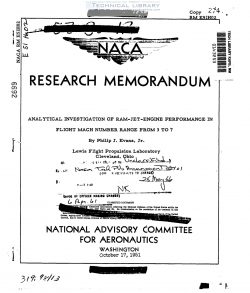naca-rm-e51h02
- Version
- 43 Downloads
- 1.04 MB File Size
- 1 File Count
- May 25, 2017 Create Date
- May 25, 2017 Last Updated
National Advisory Committee for Aeronautics, Research Memorandum - Analytical Investigation of Ram Jet Engine Performance in Flight Mach Number Range from 3 to 7

An analytical investigation was made of the performance of isolated
ram—jet engines in the flight Mach number range from 3 to 7. Calcula-
tions were made for two types of diffuser: a high—efficiency diffuser
of unspecified.form having a kinetic-energy efficiency of 0.92, and a
simple normal-shock diffuser. A combustion efficiency of 100 percent
and a fuel having a hydrogenrcarbon ratio of 0:168 were-assumed.
Important conclusions were: (1) a design altitude of 100, 000 feet
appears desirable for a high-efficiency, high Mach number ramrjet
engine, and (2). gasoline provides sufficient energy release for maximum
engine efficiency in the flight Mach number range investigated.
The calculated maximum propulsive-thrust coefficient for an
externally mounted ram.jet_having a high-efficiency diffuser decreased
continuously from approximately 2.15 at a flight Mach number of 3 to
0‘57 at a flight Mach number of 7. The maximum engine efficiency
reached a peak of 0.47 near a flight Mach number of 5 and then '
decreased to 0.45 at a Mach number of 7.
Because of lack of information on'ramrjet design and performance
at high Mach numbers, primary consideration has been given the rocket
for vehicle propulsion above a flight Mach number of 4 within the
earth's atmosphere.
In order to determine whether consideration should also be given
the ram jet in the high Mach number range, an analysis was made at i
the NACA Lewis laboratory of ramrjet performance at zero angle of 3 /
attack for flight Mach numbers between 3 and 7. The computed perform- :
ance was based on a hydrocarbon fuel having a hydrogen—carbon ratio ¥
of 0.168. However, because of the narrow range of hydrogen-carbon
ratio and the similarity of combustion products, the same results i>§g
should be obtained with most of the available hydrocarbons. In fact,
it seems reasonable to expect that many nonhydrocarbons burning at
the same value of energy addition will yield approximately the same
thrust and engine efficiency. Consequently, results are presented in
terms of an energy-addition parameter so that they will be more
generally applicable.
| File | Action |
|---|---|
| naca-rm-e51h02 Analytical Investigation of Ram Jet Engine Performance in Flight Mach Number Range from 3 to 7.pdf | Download |

Comment On This Post